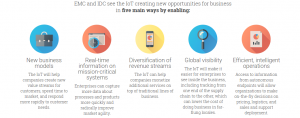The internet of things and big data: Unlocking the power by Charles McLellan.
From the post:
…
If you have somehow missed the hype, the IoT is a fast-growing constellation of internet-connected sensors attached to a wide variety of ‘things’. Sensors can take a multitude of possible measurements, internet connections can be wired or wireless, while ‘things’ can literally be any object (living or inanimate) to which you can attach or embed a sensor. If you carry a smartphone, for example, you become a multi-sensor IoT ‘thing’, and many of your day-to-day activities can be tracked, analysed and acted upon.
Big data, meanwhile, is characterised by ‘four Vs‘: volume, variety, velocity and veracity. That is, big data comes in large amounts (volume), is a mixture of structured and unstructured information (variety), arrives at (often real-time) speed (velocity) and can be of uncertain provenance (veracity). Such information is unsuitable for processing using traditional SQL-queried relational database management systems (RDBMSs), which is why a constellation of alternative tools — notably Apache’s open-source Hadoop distributed data processing system, plus various NoSQL databases and a range of business intelligence platforms — has evolved to service this market.
The IoT and big data are clearly intimately connected: billions of internet-connected ‘things’ will, by definition, generate massive amounts of data. However, that in itself won’t usher in another industrial revolution, transform day-to-day digital living, or deliver a planet-saving early warning system. As EMC and IDC point out in their latest Digital Universe report, organisations need to hone in on high-value, ‘target-rich’ data that is (1) easy to access; (2) available in real time; (3) has a large footprint (affecting major parts of the organisation or its customer base); and/or (4) can effect meaningful change, given the appropriate analysis and follow-up action.
As we shall see, there’s a great deal less of this actionable data than you might think if you simply looked at the size of the ‘digital universe’ and the number of internet-connected ‘things’.
…
On the question of business opportunities, you may want to look at: 5 Ways the Internet of Things Drives New $$$ Opportunities by Bill Schmarzo.
A graphic from the report summarizes those opportunities:
Select the image to see a larger (and legible) version. Most of the posts where I have encountered it leave it barely legible.
See the: EMC Digital Universe study – with research and analysis by IDC.
From the executive summary:
In 2013, only 22% of the information in the digital universe would be a candidate for analysis, i.e., useful if it were tagged (more often than not, we know little about the data, unless it is somehow characterized or tagged – a practice that results in metadata); less than 5% of that was actually analyzed. By 2020, the useful percentage could grow to more than 35%, mostly because of the growth of data from embedded systems.
Ouch! I had been wondering when the ships of opportunity were going to run aground on semantic incompatibility and/or a lack of semantics.
Where does your big data solution store “metadata” about your data (both keys and values)?
Or have you build a big silo for big data?
